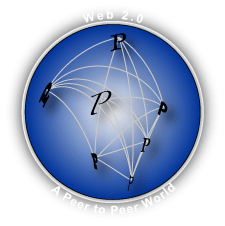2009 Poised as Inflection Point in Enterprise Usage—LinkedIn Increases Relevance to B2B Executives
 During the 1990s, I was intimately involved with helping global organizations to decentralize their information technology—as a management consultant and marketing executive. However, a far more disruptive force is imminent today: communications and marketing are rapidly evolving into a networked, distributed pattern, following IT’s lead. Individuals that congregate online will have an increasing role in affecting how other people make decisions, significantly weakening the influence of the mass media on which many marketing strategies depend. Organizations that depend on centralized, controlled communications will be astonished at how fast they become irrelevant over the next five years. Although the case studies are still being written, I’ll go on record as saying that the 2008 U.S. presidential election will prove to be an inflection point of digital social networks’ disruptive potential.
During the 1990s, I was intimately involved with helping global organizations to decentralize their information technology—as a management consultant and marketing executive. However, a far more disruptive force is imminent today: communications and marketing are rapidly evolving into a networked, distributed pattern, following IT’s lead. Individuals that congregate online will have an increasing role in affecting how other people make decisions, significantly weakening the influence of the mass media on which many marketing strategies depend. Organizations that depend on centralized, controlled communications will be astonished at how fast they become irrelevant over the next five years. Although the case studies are still being written, I’ll go on record as saying that the 2008 U.S. presidential election will prove to be an inflection point of digital social networks’ disruptive potential.
LinkedIn is a leading venue for B2B and B2C executives, so it merits significant attention. The inputs for this Executive Adoption Snapshot are varied: I have had the opportunity to work with hundreds of executives to apply LinkedIn to their business processes in 2008. I met two LinkedIn executives this month, and I covered CEO Dan Nye’s recent interview. I will synthesize clients’ experiences and LinkedIn executives’ remarks in three sections: 1) Executive Summary, 2) remarks from Dan Nye, Patrick Crane and Steve Patrizi, and 3) Analysis and Conclusions.
I would also be remiss if I did not share some of my experience around what kind of services enterprises will require to excel in this new environment, so after Analysis and Conclusions, I have provided initial thoughts gleaned from my experiences with clients thus far working with Web 2.0.
Executive Summary
Why Social Networks and Web 2.0 Will Surprise Most Executives in 2009
- We all have difficulty perceiving phenomena that don’t fit patterns we recognize. To whit, many enterprise executives remarked in the mid 1990s that “no serious company would have to use the Internet for business.” The chairman of IBM once declared that there would be a market for perhaps five computers in the world. It took businesses decades to learn how to use the telephone. Today, most accomplished business executives do not understand how to use digital social networks.
- As Web 1.0 (the Internet) changed the economics of information access and transaction, social networks are changing the economics of relationships. The networks sharply reduce the costs of finding people with very specific characteristics (potential clients, employees, business partners, external experts) as well as the cost of developing relationships and trust between people. Cost reductions are in time and money.
- Social networks exhibit the network effect, whose power begins slowly but accelerates quickly. As 2008 closes, many executives discount the importance of the networks because, although memberships have been increasing significantly in 2008, few revolutionary changes have materialized. This is deceptive but easily explainable: members of the networks do not know how to apply them to change their business processes. In the 1920s, just because you ordered twenty telephones for your front office, that didn’t mean that you knew how to use them to change your sales process.
- As Dan Nye remarked, LinkedIn worries less about competitors than about teaching executives the importance of digital social networks.
What Kind of Network?
 Simplistically, there are two types of “providers” of digital social networks: open and proprietary. LinkedIn, Xing, Bebo and Facebook are examples of open, cross-boundary networks. There are dozens of proprietary, “white label” providers that build private social networks for companies. Some examples are: Small World Labs, Neighborhood America, KickApps and VisiblePath. A variation of the latter is enterprise software vendors that are bolting on social functionality to their collaboration suites like Lotus Connections, Microsoft Sharepoint and SAP and Oracle.
Simplistically, there are two types of “providers” of digital social networks: open and proprietary. LinkedIn, Xing, Bebo and Facebook are examples of open, cross-boundary networks. There are dozens of proprietary, “white label” providers that build private social networks for companies. Some examples are: Small World Labs, Neighborhood America, KickApps and VisiblePath. A variation of the latter is enterprise software vendors that are bolting on social functionality to their collaboration suites like Lotus Connections, Microsoft Sharepoint and SAP and Oracle.- Companies often want to know “which one” (open, closed) to use, and the answer is usually “open” or “both.” The emphasis is on harnessing open networks, which can coexist very well with hived off proprietary networks if designed appropriately.
- For executives who are focused on peers in management, LinkedIn is a very compelling platform. Moreover, LinkedIn has been designed with executives in mind; it doesn’t overwhelm as does Facebook, but it fully leverages the power of P2P (peer to peer) as do Facebook, MySpace, Orkut, Xing and others. It’s an ideal place to learn the principles and tools, and the skills are imminently transferable to other networks, too.
- That said, it is increasingly easy for people to take their “friends” and move to another network, so there can be a high degree of mobility. All networks try to build in features to increase changing costs to retain their memberships, and most succeed to a large extent. However, look no further than the relatively quick migration from MySpace to Facebook. The younger the audience, the more mobile.
The Fate of Relationships
- B2B is even more vulnerable to social networks’ disruption than B2C. Customers regularly ask each other’s advice on buying decisions in the B2C context; for an increasing range of products and services, people are learning to “trust the crowd.” B2B executives are behind the curve, but they typically have fewer trusted people and will trust each of them more when asking advice on buying decisions.
- Executive networks like LinkedIn provide tools that make this much easier, but most executives don’t know why or how to use them yet. Watch out: they will adopt strongly in 2009.
- Digital social networks will rapidly change companies’ relationships with employees and customers forever, which is an astounding opportunity (and threat). Open networks like LinkedIn enable employees who leave the company to remain connected with their trusted connections at the company. True, this can serve as a threat when employees go to competitors, but it’s also a tremendous opportunity when they go to partners and customers. Smart companies will encourage this and focus on helping employees to create rich sets of relationships.
- Likewise, customers and non-employees will increasingly influence your clients’ buying behavior, so marketing will increasingly be about engaging them and providing them with tantalizing inside information and exemplary experiences with your company. Survey after survey shows that marketers’ staple investments have a rapidly decreasing impact on buying behavior (mass advertising and marketing), while specific advice from “someone like me” has an increasing impact. As adoption proceeds, this will be even more true. The challenge for marketers is that they can’t buy authentic voices, they have to create authentic relationships and reputation. It’s not like advertising, where a marketer can step in, make the buy and get the impact.
LinkedIn Executive Insights
CEO Dan Nye on LinkedIn’s Growth and Strategy
 LinkedIn has grown very quickly, and the company has a lot to be proud of. It is quickly becoming the leader of executive networks in many parts of the world. Tellingly, LinkedIn’s biggest challenge is executives’ lack of understanding of why to use it and how. This temporarily weakens the significance of the rapid growth of the memberships of LinkedIn and others like Xing, Orkut, Bebo and others. People don’t yet know how to use the tools to create business value.
LinkedIn has grown very quickly, and the company has a lot to be proud of. It is quickly becoming the leader of executive networks in many parts of the world. Tellingly, LinkedIn’s biggest challenge is executives’ lack of understanding of why to use it and how. This temporarily weakens the significance of the rapid growth of the memberships of LinkedIn and others like Xing, Orkut, Bebo and others. People don’t yet know how to use the tools to create business value.
- LinkedIn is on track to have 35 million members by year-end 2008. A new member joins every second of every day, 24/7. Moreover, half the members are outside the U.S. This can significantly lower the cost of going global.
- LinkedIn derives much of its differentiation from the fact that it is a business network; (LinkedIn doesn’t compete with “social” networks because) executives want to have a distinct digital network for business. Let’s face it, not all your Facebook content is appropriate for client or colleague viewing and, should you choose to sanitize it, the fun would go out of it.
- LinkedIn’s member demographics edged out those of several business executive stalwarts: 42 years old, $109,000 average household income and 60% male. They were considerably younger and had a higher household income than the Wall Street Journal, Business Week and several others.
- As a business network, LinkedIn has a unique social context. Executives who learn how to conduct themselves in this unique environment will enjoy an increasing advantage as LinkedIn continues to grow (anyone you want to know will increasingly be on it).
- LinkedIn is well positioned to survive the vagaries of the economy because it has a pile of cash and Nye thinks they will do even better when jobs are harder to get:
“You know what, connecting with people I know and reaching out and learning how these Internet tools are used and presenting myself so that I can be found on the Internet is valuable and important.”
- LinkedIn worries less about competitors than about educating executives. “I actually think that what we’re trying to do is focus our competitive juices on enlightening people and helping people who are not participating in a professional network, to understand the importance. So if we maintain a maniacal focus on helping people understand what they can accomplish on the network, that is where we need to concentrate all of our energies.”
- This is a summarized account; read full coverage here.
Patrick Crane, LinkedIn Marketing Executive, on Strategic Direction and B2B Business Opportunities
 Patrick Crane shared insights about LinkedIn, Inc’s strategy as well as ideas for B2B executives to use the emerging platform to drive their businesses. A key point is that LinkedIn makes the people in one’s network actionable (and more valuable). Everyone’s clickable, and LinkedIn drives down transaction costs, which means people who use it can have more transactions; they can manage larger networks.
Patrick Crane shared insights about LinkedIn, Inc’s strategy as well as ideas for B2B executives to use the emerging platform to drive their businesses. A key point is that LinkedIn makes the people in one’s network actionable (and more valuable). Everyone’s clickable, and LinkedIn drives down transaction costs, which means people who use it can have more transactions; they can manage larger networks.
- LinkedIn is a new global medium of communication and collaboration for executives. It accelerates the way people have been doing business for years, and the focus is on “friends”—and even more on “friends of friends.” According to LinkedIn, quality trumps quantity in networks.
- LinkedIn makes the “six degrees” concept real (for business executives) because it provides useful intelligence they can act on (“social” information like who their friends are, what do they care about, where they’ve worked and volunteered).
- For the 21st century Web 2.0 economy, using LinkedIn is like using the telephone was at the beginning of the 20th century, during the early industrial economy. It is core, but in the beginning, people need help to appreciate its relevance.
- Although it may seem counterintuitive to most CMOs, LinkedIn presents a great crowdsourcing venue: ask your customers. Crane shared an impressive example in which Southwest Airlines’ CEO asked a question about how airlines could improve passenger productivity. Tremendous results: customers gave all kinds of valuable advice and generated extensive goodwill, all for millions to see.
- Crane presented a timeline plotting global membership against time:
- Past: 2003—300,000 members | 2005—3,500,000 members | 2006—13,000,000 members
- Present/Future: 2008—35,000,000 members | 2009—60,000,000 members | 2012—150,000,000 members
- Businesses can leverage the significant insight about LinkedIn members when they respond to surveys, polls and targeted advertising—even though LinkedIn won’t share the identities of who exactly responded to what. It will share characteristics.
- LinkedIn can increasingly be regarded as a global trend “early warning system” because the behaviors emerge on LinkedIn; Crane cited green business as one example that had showed earlier on LinkedIn than in the media.
- A few data points on global adoption: the most wired country is Denmark, where 20% of all white collar workers are on LinkedIn; by that definition, the U.S. lags at 12%. LinkedIn is waiting on China; they realize that they have to think through the cultural differences. India is a natural and is growing quickly.
- Politicians are using LinkedIn; Obama, for example, asked questions before a big California fundraising trip, and the questions engaged influencers.
- LinkedIn will be increasingly key to reaching the all-important SMB/SME (small medium business/enterprise) segment. 5-7 million LinkedIn members manage or own small businesses, and they depend significantly on the advice of their friends prior to making major purchase decisions.
- LinkedIn today still has little brand awareness, which the company is trying to address, largely through alliances and its blog, which is now the eighth-most read corporate blog; LinkedIn is vying to be a huge brand, but its budget is modest. Its strategy and brand concept is enabling collaboration.
- Results are emerging but can be quite impressive. Crane cited a private equity firm that used LinkedIn to connect with several executives in India for due diligence; it made the investment and quickly realized $250 million in profit.
- This list is much summarized; read the expanded version, which also contains numerous “hands-on” tips.
Steve Patrizi, LinkedIn Advertising Sales Executive, on Social Networks’ Disruptive Potential
 Steve Patrizi presented two disruptive ideas: that B2B is ripe for rapid change as executives will adopt quickly once they understand the concepts of trusting people online (counterintuitive at first, trusting “strangers”). Second, LinkedIn advertising clients are beginning to refer people who click on ads to their employees on LinkedIn. This reflects the profound change posed by Web 2.0. In more cases than you can imagine, an executive who clicked on a highly targeted ad in LinkedIn would be far more responsive if she could talk with another executive at your company, not a generic account executive.
Steve Patrizi presented two disruptive ideas: that B2B is ripe for rapid change as executives will adopt quickly once they understand the concepts of trusting people online (counterintuitive at first, trusting “strangers”). Second, LinkedIn advertising clients are beginning to refer people who click on ads to their employees on LinkedIn. This reflects the profound change posed by Web 2.0. In more cases than you can imagine, an executive who clicked on a highly targeted ad in LinkedIn would be far more responsive if she could talk with another executive at your company, not a generic account executive.
- Steve has been in advertising for many years, and he sees that things are changing rapidly, even though it’s not obvious at first. Brand is what a friend tells a friend in IT Toolbox or LinkedIn Answers. LinkedIn encapsulates numerous technologies that increase the options for connecting with people; people can now aggregate and congregate wherever, whenever, however, and their opinions are increasingly heard.
- B2B is more vulnerable to disruption than B2C because there are fewer customers, and customers are more likely to ask each other’s advice before buying. B2B customers are discovering how easy it is to ask each other for advice, as LinkedIn and other venues make this very easy and maximize credibility.
Leverage your own people, they are your best asset, and they represent your brand (more than your glossies); they are a natural bridge to customers and prospects; take an offensive stance and try to set the expectation that every employee have a LinkedIn profile.
- Don’t be afraid that recruiters will poach employees due to their LinkedIn profiles; they’re out there anyway, so focus on keeping them happy. Steve cited IBM’s Social Computing Guidelines for employees; he recommended that companies create their own “social computing guides”; however, don’t use a heavy-handed approach or try to control it.
- Use LinkedIn Answers to listen. Relative to your business, what are people talking about? Ask yourself, “Who are the experts in my business?” Expertise is transparent on LinkedIn, and (although he didn’t put it in these words) you should treat the experts as you treat analysts now; what experts think and write on LinkedIn can have serious impact on your business.
- Surveys are a new option on LinkedIn, and Steve demonstrated some impressive examples: unlike “normal” advertising, LinkedIn knows intense amounts of information about its members who respond to surveys (even though it does not disclose members’ identities to advertisers (companies paying for surveys). Polling is a related but distinct option for advertisers as well as direct advertisements.
- Steve uncorked this quintessential Web 2.0 concept: in some cases, advertisers should point prospects to their employees on LinkedIn, rather than to a website (as in, “click the ad, navigate to certain employees”); think about that a minute: especially for B2B, that’s a revolutionary idea.
- Everyone is clickable in Linkedin, which means s/he’s accountable, and there is minimal bad behavior. Another underlying principle of LinkedIn is the trusted connection, so be careful who you accept as a “trusted” connection. LinkedIn is increasingly boosting the value of sharing information among your connections, which increases the trust premium.
Analysis and Conclusions
LinkedIn Epitomizes Executive Digital Social Networks
 LinkedIn can significantly reduce “time to relevance” for those who know how to use it (the minority right now). For example, you are meeting with a prospect for the first time; by looking up her profile, you increase the chances of having a relevant conversation by knowing where she’s worked, who you know in common and even what she thinks about certain business challenges through her activity in the Answers forums. Multiply that concept by the number of people on your sales and product teams, and you can imagine the business impact it will have. When case studies accelerate (I project 2009), customer behavior will begin to change very quickly.
LinkedIn can significantly reduce “time to relevance” for those who know how to use it (the minority right now). For example, you are meeting with a prospect for the first time; by looking up her profile, you increase the chances of having a relevant conversation by knowing where she’s worked, who you know in common and even what she thinks about certain business challenges through her activity in the Answers forums. Multiply that concept by the number of people on your sales and product teams, and you can imagine the business impact it will have. When case studies accelerate (I project 2009), customer behavior will begin to change very quickly.- For a more in-depth take on this, see How Social Networks Make Markets More Efficient for Buyers and Sellers.
- Companies that don’t understand Alumni 2.0 and that have employees who don’t know how to use social networks for business will be at a significant disadvantage. Most of the barriers are mental and behavioral, so it’s essential to begin adopting as aggressively as possible. Remember that few companies had any IT people who knew anything about the Internet at the end of the 1990s. Overnight, they had to pay a mint and couldn’t keep people anyway.
This will be more painful because companies won’t be struggling to keep IT people, who have a key support role at many companies, they will be struggling to keep people on the front lines of their business (client-facing, relationship people).
- LinkedIn is very in synch with Web 2.0, even though it’s not currently considered as sexy as Facebook or Twitter. Everybody with a mobile phone, an email and a Linkedin Profile is open for business globally. The people who can represent themselves, through other people and public deeds, will have the advantage. It’s that simple.
21st Century Human Capital
- To leverage your best asset, employees, you have to let them act like people. Although it’s easy to discredit because it’s so often repeated, the age of the few controlling communications and opinion is rapidly collapsing, and this is true in the context of “brand management” and “employee management.” Employees are free agents in all but name (more on this here, which invokes some interesting IBM research), and this fact helps companies to treat them as variable costs. But companies can’t have it both ways: they have to learn to love mobility when it’s employee-initiated.
- Borrow a revolutionary (Silicon) Valley idea: use LinkedIn to transform the employment paradigm. Help employees look their best on LinkedIn, even though some will appear more desirable to outsiders and will be poached. But all employees will be more approachable by customers and prospects. To get more of an idea of this, see Enterprise Profile Programs.
- When your company focuses on making the employee experience truly excellent, interesting things happen:
- Employees like working at your company more, and they stay for the right reasons
- When employees morph into alumni (BTW, have you ever noticed that companies always have more alums than employees?), and you have encouraged their use of LinkedIn, guess what happens? You have helped them to build a seamless bridge back to your company. Yes, some employees will go to companies you consider competitive, but more will go to companies adjacent to yours in the value
chainnet—or to your clients. Wouldn’t that be awful? - Seen in this light, Steve’s advice to enthusiastically encourage the use of LinkedIn is generally good general business, but most companies will be doubly rewarded because alums become trojan horses that beget future opportunities when they use a third-party network like LinkedIn—because they remain connected to you automatically and the connections are actionable. Note you only maximize this when you focus on creating superlative employee experience, and you believe that employees will do the right thing most of the time.
- LinkedIn reduces the transaction costs of letting employees flow into your company—and out. This will enable most companies to perform at a higher level.
- More on this in Using Social Networks for Process Innovation, which I presented at the Social Networking Conference in July 2008.
- Highly related to this was Steve’s suggestion to link ads to your employees’ LinkedIn profiles. That sends a very strong message. It’s personal, but it also suggests that you can run highly targeted ads on LinkedIn.
- If you’re a visionary company, you are going to realize that the more visible employees you have, the better relationships your company will have, the more profitable accounts you’ll have. Employees can be conduits to your company through LinkedIn, but you’ll need to guide them.
- Enterprise executives’ key blind spot is failing to appreciate the power of emergent organization and cross-boundary collaboration. This is why LinkedIn’s vision for Apps (they invoke blog posts, your calendar, your documents, etc. from your LinkedIn Profile) is so transformational. Experts can coalesce rather seamlessly around idea and opportunity, without having to incur the cost of employment or other “hard bonds” that were previously table stakes. This is why most organizations will be well served to understand Web 2.0 and apply it as quickly as feasible: as the telephone and the automobile remade towns, Web 2.0 will remake organization itself.
Marketing 2.0
- B2B is more vulnerable than B2C. This was the most far-reaching point Steve made and completely worth the day by itself—to people who got it and will act on it. It confronts a hidden assumption: that B2B’s late adoption of social networks equates to little impact. B2B has lagged B2C significantly in the adoption of social networks, but Steve’s argument was convincing that, once executives learn they can trust other executives in executive communities, they will adopt profoundly. It is only a matter of timing.
- Realize that you need to have a visible executive to aggressively lead the effort to apply LinkedIn (and other Web 2.0) to internal and external processes. If LinkedIn turns out to be the telephone of the 2010s, the sooner you learn to apply it to your business, the more competitive advantage you’ll enjoy. If you haven’t seen it yet, you may want to explore the Social Network Roadmap, which is designed to facilitate enterprise adoption of Web 2.0, including LinkedIn. Full disclosure: I designed it.
- The centralized selling and marketing of the 20th century will still have a role, but I predict it will morph to largely supporting people (employees, customers, bloggers, students, politicians…) who will do much of the end influencing. Yes, most “selling” will be distributed: people with no formal affiliation with your company will influence a huge portion of sales. Linkedin can get you off to a fast start—today.
My advice to clients: already begin acting as if your clients already find each other and ask each other’s advice about resolving the challenge that your product or service addresses. This will prove more disruptive than anything you have experienced because online forums offer a far greater diversity of perspectives and solutions that may influence the client to substitute a completely different solution.
- On the opportunity side of the ledger, LinkedIn Answers will enable your product or service management executives to broaden their peripheral vision, but they must invest—and it doesn’t have to be a lot of time, but it should be consistent. Have your product team commit to answering and asking a given number of questions in a given time period.
- If you have been a casual member of LinkedIn, you may not have read between the lines regarding the profile and its link to marketing and advertising. Rich profile information, especially if appropriate meta-information is built around the data objects, could be used to represent decisions made by executives; in this way, LinkedIn might be able to get close to inferring decisions given certain situations. LinkedIn could be able to give advertisers and marketing researchers unprecedentedly rich information, much more quickly and inexpensively than any other source; keep in mind LinkedIn’s demographics. I can easily imagine this when I look at polls and advertising. Do yourself a favor, pay attention to polls and think about the power of using them. In your mind, look at the depth of information LinkedIn can provide about the people who answered the polls.
- I like the way that LinkedIn is approaching Apps; it reminds me of Apple’s intense focus on experience. This bodes well for LinkedIn as a company because it reflects their focus on executives’ experience. To succeed, they must build and maintain trust by appreciating their ultimate clients’ time sensitivity and motivations.
Professional Services for Enterprise Use of Digital Social Networks
This section is a very short summary that merits a much longer treatment. It draws from my experience with advising a wide group of executives since 2006, from a Wall Street bank to smaller companies and individual executives. In my opinion, organizations most pressingly need pilots in which they use social networks for real business processes, so they can start up the learning curve. For many companies, LinkedIn is an excellent place to start.
- Experience LinkedIn within the context of your crucial business processes because process owners need to understand the potential as quickly as possible. You can use it to significantly improve business development, sales, talent acquisition, marketing, R&D, the list is endless. Social networks drastically reduce the time spent in discovery, discovery of relevant expertise and access that your company needs to excel. Networks can also reduce the cost of developing relationships. They do not take the place of your current relationship building processes, but they should displace much of the information-gathering and some of the initial bonding. If you aren’t coming up the learning curve as quickly as possible, you are making yourself vulnerable to competitors who will.
- For some examples, review some of the services offered by the Executive’s Guide to LinkedIn, one of my service lines. The easiest way to get a hands-on taste is to sign up for a public seminar.
- Realize that most of your employees are increasingly on LinkedIn, and most profiles are far below par. This gives your company a golden opportunity to help them to show themselves in their best light while representing your company. To produce the best effect, this must be done carefully: in most cases, you cannot dictate what employees put on their profiles. See LinkedIn Profile Management Programs.
- Create a policy for employees’ and partners’ participation in Web 2.0 venues. Also think about creating incentives for employees who introduce new prospects. These need not be financial.
- Companies that have been experimenting may want to drive adoption quickly by using a formalized approach by which they can align numerous stakeholders. The Social Network Roadmap is designed to mitigate the risks posed by Web 2.0, thereby enabling more rapid adoption. I have published extensive thought leadership on this.

Leave a Reply
You must be logged in to post a comment.